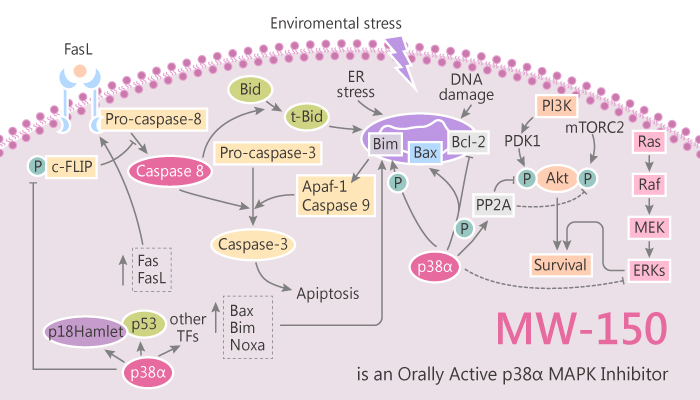Currently, a void exists for serine/threonine protein kinase inhibitor drugs and central nervous system indications. Stress kinases are of special interest in neurological and neuropsychiatric disorders, because of their involvement in synaptic dysfunction and complex disease susceptibility. Clinical and preclinical evidence implicates the stress related kinase p38α MAPK as a potential neurotherapeutic target. However, the isoform selective p38α MAPK inhibitor candidates are lacking. In addition, the mixed kinase inhibitor drugs that are promising in peripheral tissue disease indications have limitations for neurologic indications. In this study, MW-150 is an isoform selective p38α MAPK inhibitor. It promises pharmacological features and in vivo CNS efficacy.

MW-150 shows a Ki of 101 nM for p38α MAPK. It displays approximately 10-fold selective better than that for p38β MAPK, 14-fold selective better than that for p38δ MAPK, and 6-fold selective better than that for the atypical NLK. MW-150 inhibits in a concentration-dependent manner the ability of the endogenous p38α MAPK to phosphorylate an endogenous substrate, MK2. MW-150 treatment attenuates the downstream increase in proinflammatory cytokine production. Furthermore, MW-150 treatment blocked in a concentration-dependent manner the increased IL-1β production by activated glia. The IC50 values for these MW-150 cellular activities are 332 nM (MK2) and 936 nM (IL-1β).
In vivo, MW-150 improves the APP/PS1 transgenic mice performance in radial arm water maze and contextual fear conditioning tests. in additon, treatment of 11–12 month old mice with MW-150 suppresses the cognitive impairment. MW-150 treatment in APPNLh/NLh × PSP264L/P264L knock-in mouse exhibits RAWM behavior indistinguishable from WT mice.
In summary, MW-150 is a chemically stable and orally bioavailable p38αMAPK inhibitor. Meanwhile, it exhibits excellent cell permeability, absence of efflux pump and CYP liabilities, adequate metabolic stability and possessing minimal risk for adverse pharmacology liabilities.
Reference:
Roy SM, et al. ACS Chem Neurosci. 2015 Apr 15;6(4):666-80.